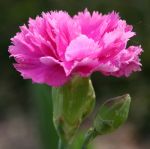| Common Name: |
Wild Carnation |
| Other Names: |
Clove Pink |
| Botanical Name: |
Dianthus caryophyllus |
| Genus: |
Dianthus |
| Family: |
Caryophyllaceae |
| Native Location: |
S Europe, N Africa |
| Cultivation: |
Well-drained, neutral to alkaline soil in sun. May be affected by a number of diseases, especially when grown under cover, including Botrytis, Fusarium, and Verticillium wilts, powdery mildew, and leaf and stem rots. |
| Propagation: |
By seed swon in spring or autumn at 13°C (55°F); by cuttings of non-flowering shoots in summer. Dianthus chinensis is usually grown as an annual. |
| Harvest: |
Flowers of D. caryophyllus are picked after 3 hours exposure to morning sunshine and used fresh for oil extraction and culinary use, or dried for potpourris. Plants of D. chinensis are cut just before the flower buds open and dried for use in decoctions, pills, powders, and poultices. |
| Height: |
20-50cm (8-20in) |
| :Width |
15-23cm (6-9in) |
| Hardiness: |
Z5-8 |
| Parts Used: |
Flowers, oils |
| Properties: |
An aromatic, stimulant herb that lowers fevers. |
| Medicinal Uses: |
Internally for nervous and coronary disorders. Once used in tonic cordials to treat fevers. |
| Culinary Uses: |
Fresh petals, with the bitter white base removed, are added to salads, candied, pickled in vinegar, and made into a syrup. |
| Economic Uses: |
Flower heads are dried for potpourris; oil is extracted for use in perfumery. |
| Bibliography: |
Encylopedia of Herbs by Deni Brown Copyright ©: 1995, 2001 Dorling Kindersley Limited pg 192
|

